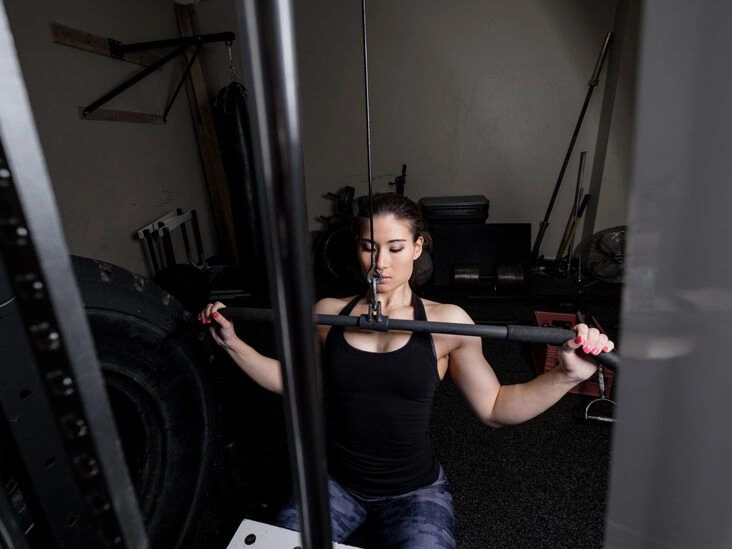When performing a lat pulldown, aim to control the movement and avoid leaning too far backward while pulling. It’s best to keep a straight back and reduce the weight if you can’t preserve proper technique.
Aside from the bench press, the lat pulldown ranks among the most familiar exercises in the gym.
It’s a go-to for people trying to build back muscle mass and craft the V-shaped torso sought after by bodybuilders, lifters, and fitness fans alike.
The movement offers numerous variations you can do with minimal changes, often only by switching the grip or handle.
Additionally, you can modify the exercise to emphasize different parts of your back and adapt it to your comfort and ability.
However, because it’s so popular and versatile, the lat pulldown is frequently executed incorrectly, sometimes causing more harm than benefit. Keep in mind: solid form is essential, especially as you raise the load.
Below is everything you need to know to execute the lat pulldown safely and effectively the next time you’re at the gym.
Benefits of the lat pulldown
This exercise is a fantastic alternative to pullups or chinups if you find those difficult or are training toward being able to do them.
The lat pulldown engages many of the same muscles as a pullup, though typically to a lesser degree (1).
Because you’re seated during the lat pulldown, you can use your hip flexors and abdominal muscles to stabilize your torso while performing the movement. In fact, one earlier study noted the pulldown elicited greater abdominal activation than the pullup did.
The lat pulldown also helps athletes in sports that involve similar pulling actions, such as swimming, gymnastics, wrestling, and cross-country skiing (3).
SummaryThe lat pulldown is a suitable substitute if you struggle with pullups. It also develops muscles used in many sports, like swimming.
Muscles worked in the lat pulldown
One reason the lat pulldown is so prominent is that the overhead pulling motion recruits several key muscles in the back, shoulders, and arms.
The latissimus dorsi, or “lats,” are the broad muscles you notice on someone with a well-defined back. They are the primary movers in this compound exercise and the largest muscles of the back.
The lats are extensive — originating from the mid and lower spine, the top of the pelvis, the lower ribs, and the lower scapula, and inserting on the front of the humerus (upper arm bone).
The lats handle extension, adduction, horizontal abduction, and internal rotation of the arm. When the arm is fixed overhead, the lats pull the torso toward the arm in a climbing-like motion.
Additionally, the lats assist with breathing and may also contribute to lateral flexion and extension of the lumbar spine.
Numerous other muscles act with the lats during this exercise, including the (3):
- pectoralis major
- lower and middle trapezius
- brachialis
- brachioradialis
- teres major
- rhomboids
- biceps brachii
- infraspinatus
- wrist and hand flexors
- abdominals
Altering your grip on the bar changes the emphasis among these muscle groups.
SummaryThe lat pulldown targets multiple muscles, including the latissimus dorsi, pectoralis major, rotator cuff, and biceps brachii.
How to do the lat pulldown
- Sit at a lat pulldown station facing the bar. Adjust the knee pad so your knees are bent about 90 degrees and snug under the pad, with feet flat on the floor.
- Reach up and take the bar with a grip slightly wider than shoulder width. Extend your arms fully without shrugging your shoulders or lifting off the seat.
- Pull the bar down toward your upper chest, aiming just below the collarbone. Focus on bringing your elbows and shoulder blades down and back as you lower the bar. Keep your torso upright with a slight backward lean, roughly 70–80 degrees from vertical.
- Pause with the bar at your mid-to-upper chest for 1–2 seconds while squeezing your shoulder blades down and together.
- Slowly raise the bar back to the start. Avoid shrugging your shoulders at the top of the movement.
- Perform 2–3 sets of 8–10 repetitions.
Pro tips:
- Keep control of the movement and avoid excessive backward lean while pulling.
- Maintain a neutral back — don’t overarch or round during the pull, as this elevates injury risk.
- Reduce the weight if you can’t keep a neutral spine or correct form.

SummaryUse a grip a bit wider than shoulder width. Pull the bar down to your upper chest. Keep your back straight and avoid leaning back. Slowly return the bar overhead.
Variations on the lat pulldown
Close-grip hand position
A close grip is any hand placement narrower than shoulder width. You can use a standard lat bar or the handles used for rows. The following variation recruits the biceps brachii more strongly.
This variation is useful if you suffer forearm discomfort with wider grips or want a compound move that also targets the biceps when short on time.
- Begin seated as you would for the standard pulldown.
- Place your hands nearer the center where the cable attaches. Use a supinated grip (palms facing you).
- Pull the bar down toward your collarbone, emphasizing driving your elbows and shoulder blades down. You’ll feel greater biceps involvement in this version.
If using a rowing-style bar, perform the same movement. That bar lets you move through a larger range of motion.
Wide-grip hand position
Wide grip means placing the hands as far toward the ends of the bar as possible (wider than shoulder width).
This version emphasizes the lats and triceps more than the biceps because the dominant motion is adduction rather than adduction plus extension of the arm (6).
- Perform this version similarly to the standard-grip pulldown. You may prefer pulling to mid-chest.
- Use lighter weight to allow a fuller range of motion. Because this grip places you at a slight mechanical disadvantage, be mindful of your posture.
Straight-arm lat pulldown
This variation isolates the lats more than other forms and converts the motion to a single-joint shoulder movement.
- Stand facing the cable pulley with feet shoulder-width apart. Grab the bar with hands slightly wider than shoulder width and keep knees slightly bent.
- With elbows straight, pull the bar down toward your hips. Maintain an upright trunk and keep your head up.
- Hold for 1–2 seconds while keeping the shoulder blades down and back. Slowly return the bar overhead to the starting position.
Resistance band lat pulldown
This option is ideal for home workouts because it only requires a resistance band and an overhead anchor. You can kneel or stand depending on where the band is anchored.
You can also do this lying on your back with the band secured to a fixed point behind and above your head.
Perform the movement like the straight-arm version above, or bend your elbows and pull them down to your sides.

SummaryYou can do the lat pulldown with a wide grip to emphasize lats and triceps, a close grip to work the biceps more, with straight arms to isolate the lats, or with a resistance band at home.
The bottom line
The lat pulldown is an effective exercise for targeting the lats and recruits numerous other muscles that assist in arm extension and adduction.
It’s a useful alternative to pullups when you’re not yet able to do them unassisted and a valuable complement to pullup training.
There are many variations to keep the exercise engaging and to shift emphasis among different muscles. If you’ve been using the same technique for a while, try changing your grip and notice the difference.


















Leave a Reply
You must be logged in to post a comment.